Critique of Knowledge Management System Analysis
VerifiedAdded on 2021/04/17
|13
|1791
|39
AI Summary
This assignment requires a critique of a given analysis on the unsuccessful implementation of a knowledge management system. The analysis focuses on the poor return on investment (ROI) and suggests uninstalling the system. However, the assignment takes a more nuanced approach, highlighting the importance of considering organizational culture, existing systems, cost-benefit analysis, and user acceptance in implementing knowledge management systems. It also emphasizes the need for proper planning, user involvement, and regular updates to achieve successful ROI.
Contribute Materials
Your contribution can guide someone’s learning journey. Share your
documents today.
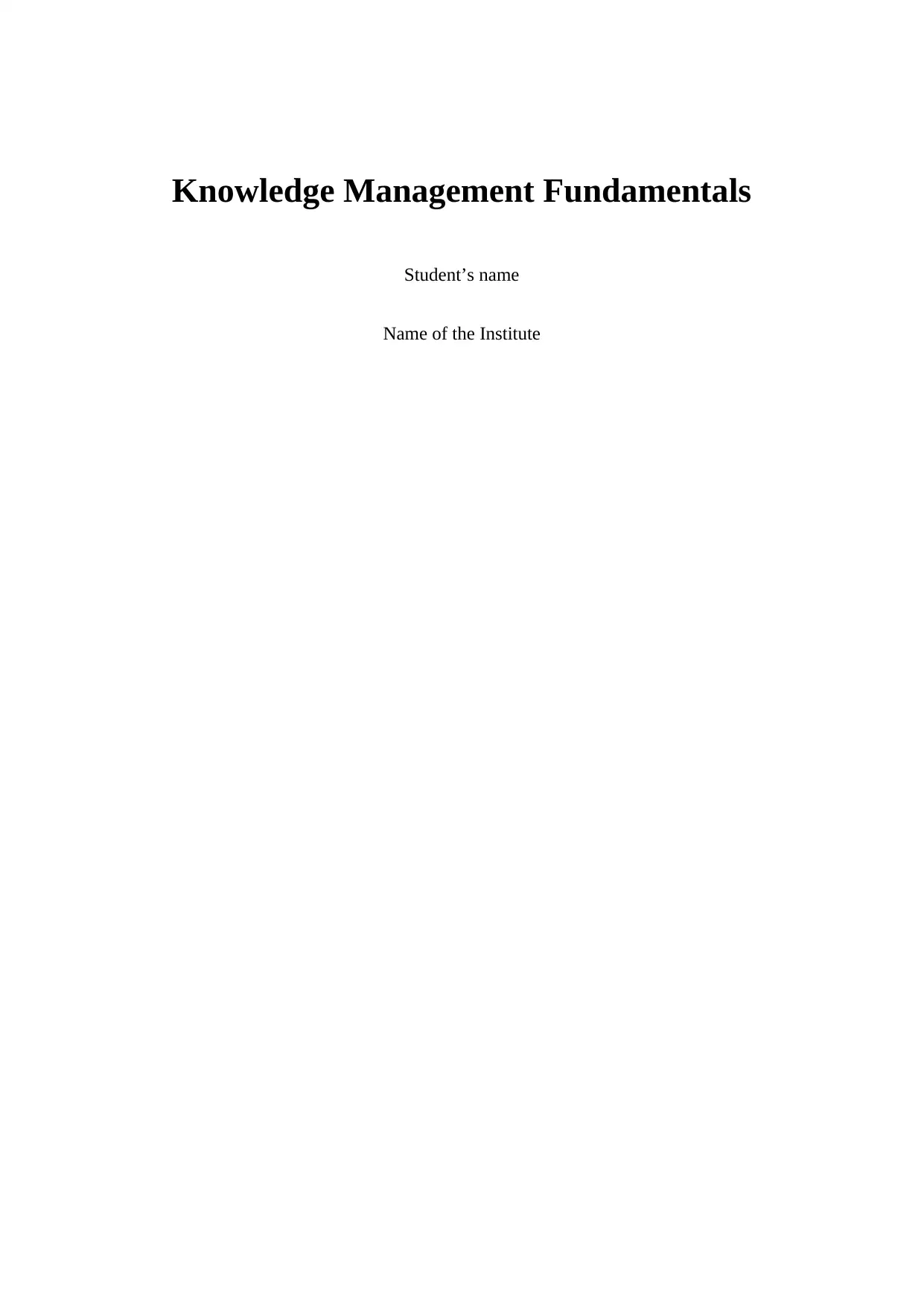
Knowledge Management Fundamentals
Student’s name
Name of the Institute
Student’s name
Name of the Institute
Secure Best Marks with AI Grader
Need help grading? Try our AI Grader for instant feedback on your assignments.
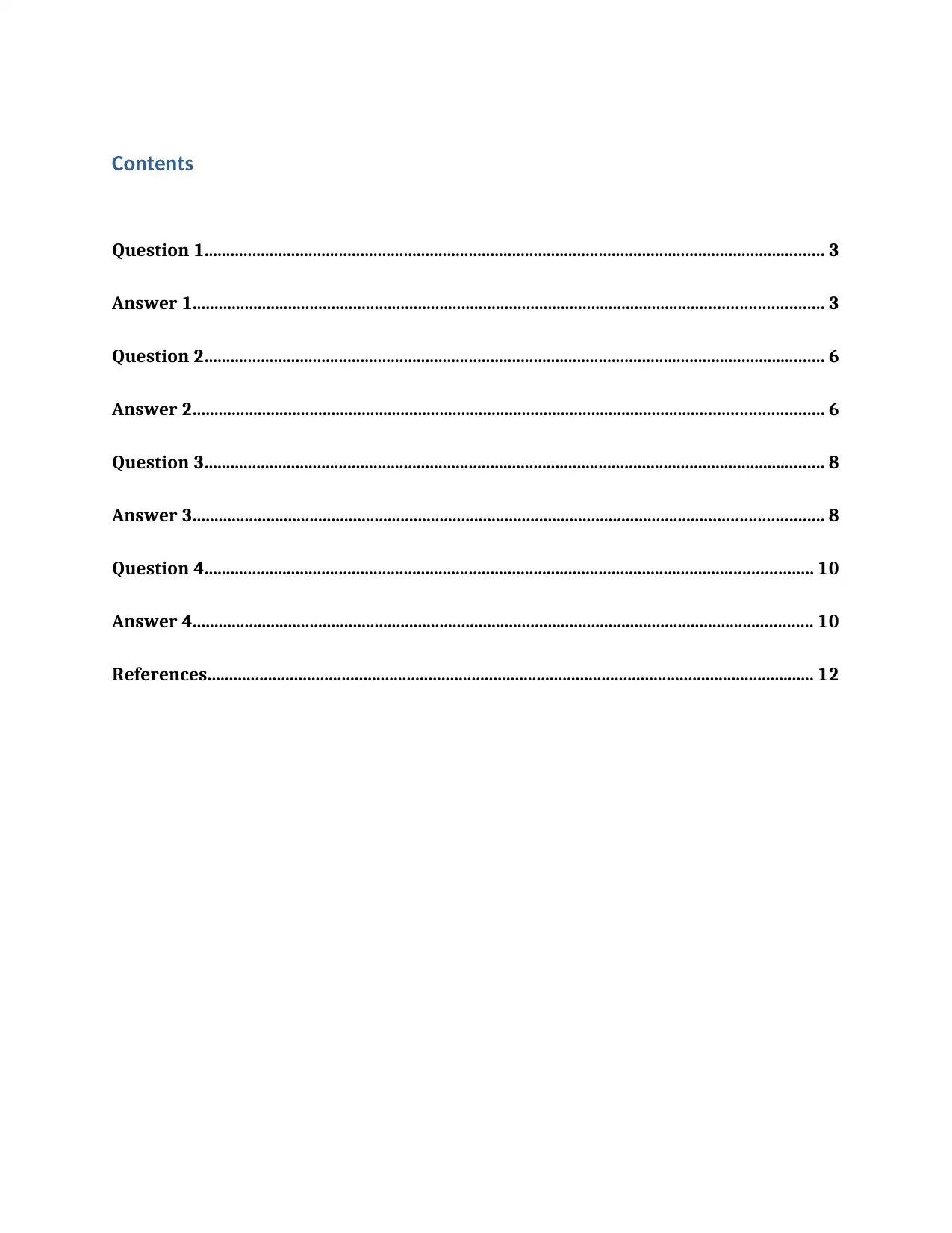
Contents
Question 1............................................................................................................................................... 3
Answer 1................................................................................................................................................. 3
Question 2............................................................................................................................................... 6
Answer 2................................................................................................................................................. 6
Question 3............................................................................................................................................... 8
Answer 3................................................................................................................................................. 8
Question 4............................................................................................................................................ 10
Answer 4............................................................................................................................................... 10
References............................................................................................................................................ 12
Question 1............................................................................................................................................... 3
Answer 1................................................................................................................................................. 3
Question 2............................................................................................................................................... 6
Answer 2................................................................................................................................................. 6
Question 3............................................................................................................................................... 8
Answer 3................................................................................................................................................. 8
Question 4............................................................................................................................................ 10
Answer 4............................................................................................................................................... 10
References............................................................................................................................................ 12
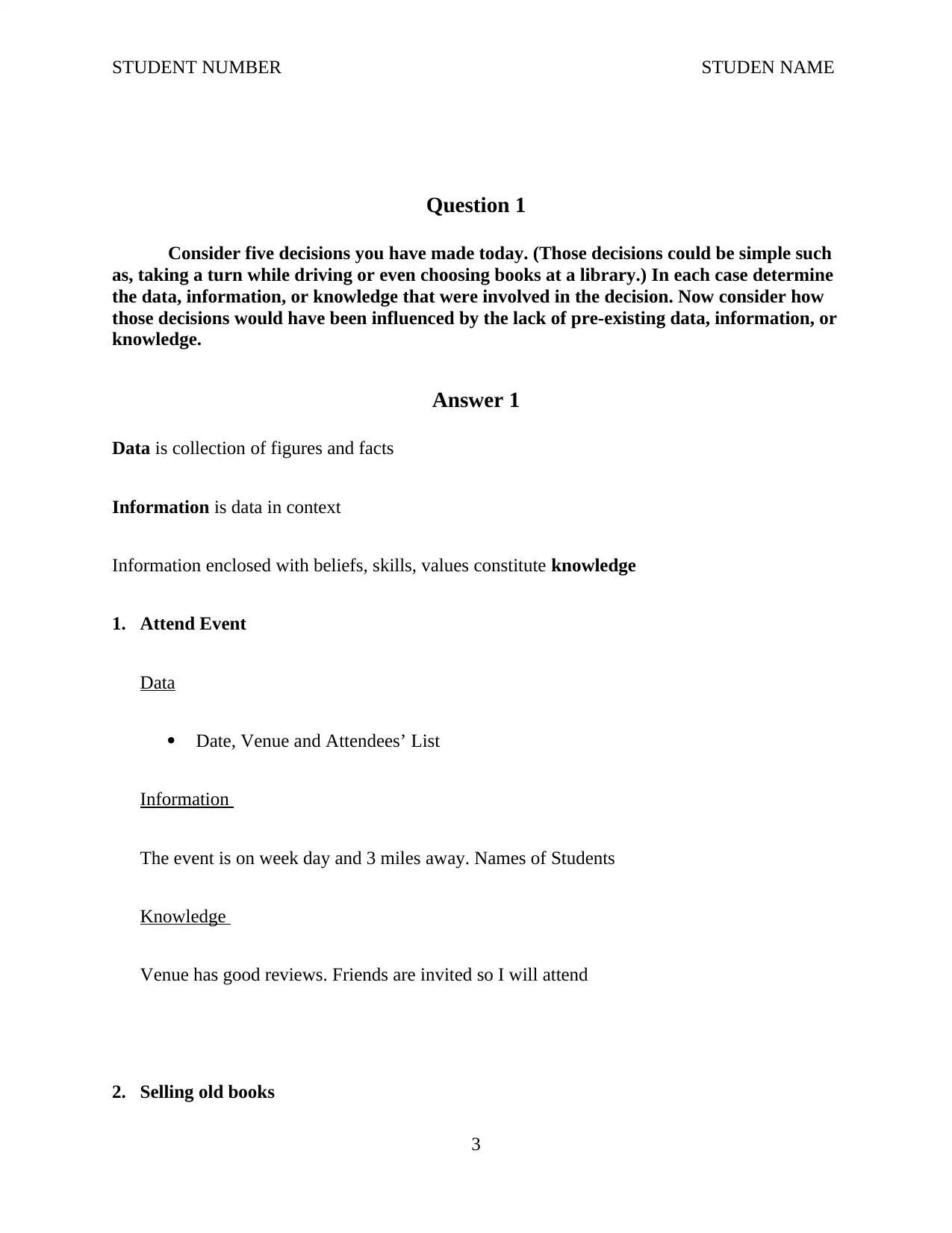
STUDENT NUMBER STUDEN NAME
Question 1
Consider five decisions you have made today. (Those decisions could be simple such
as, taking a turn while driving or even choosing books at a library.) In each case determine
the data, information, or knowledge that were involved in the decision. Now consider how
those decisions would have been influenced by the lack of pre-existing data, information, or
knowledge.
Answer 1
Data is collection of figures and facts
Information is data in context
Information enclosed with beliefs, skills, values constitute knowledge
1. Attend Event
Data
Date, Venue and Attendees’ List
Information
The event is on week day and 3 miles away. Names of Students
Knowledge
Venue has good reviews. Friends are invited so I will attend
2. Selling old books
3
Question 1
Consider five decisions you have made today. (Those decisions could be simple such
as, taking a turn while driving or even choosing books at a library.) In each case determine
the data, information, or knowledge that were involved in the decision. Now consider how
those decisions would have been influenced by the lack of pre-existing data, information, or
knowledge.
Answer 1
Data is collection of figures and facts
Information is data in context
Information enclosed with beliefs, skills, values constitute knowledge
1. Attend Event
Data
Date, Venue and Attendees’ List
Information
The event is on week day and 3 miles away. Names of Students
Knowledge
Venue has good reviews. Friends are invited so I will attend
2. Selling old books
3
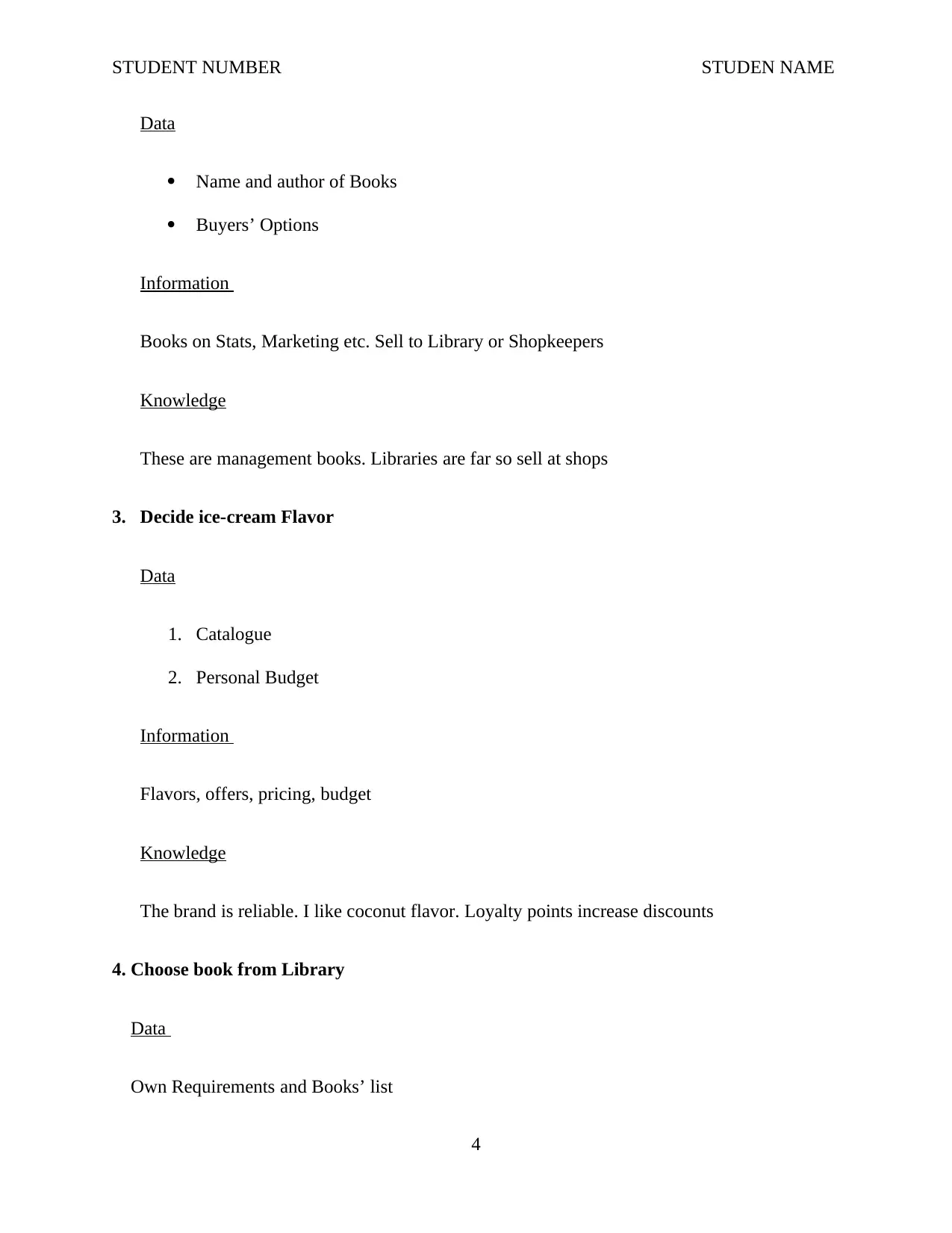
STUDENT NUMBER STUDEN NAME
Data
Name and author of Books
Buyers’ Options
Information
Books on Stats, Marketing etc. Sell to Library or Shopkeepers
Knowledge
These are management books. Libraries are far so sell at shops
3. Decide ice-cream Flavor
Data
1. Catalogue
2. Personal Budget
Information
Flavors, offers, pricing, budget
Knowledge
The brand is reliable. I like coconut flavor. Loyalty points increase discounts
4. Choose book from Library
Data
Own Requirements and Books’ list
4
Data
Name and author of Books
Buyers’ Options
Information
Books on Stats, Marketing etc. Sell to Library or Shopkeepers
Knowledge
These are management books. Libraries are far so sell at shops
3. Decide ice-cream Flavor
Data
1. Catalogue
2. Personal Budget
Information
Flavors, offers, pricing, budget
Knowledge
The brand is reliable. I like coconut flavor. Loyalty points increase discounts
4. Choose book from Library
Data
Own Requirements and Books’ list
4
Secure Best Marks with AI Grader
Need help grading? Try our AI Grader for instant feedback on your assignments.
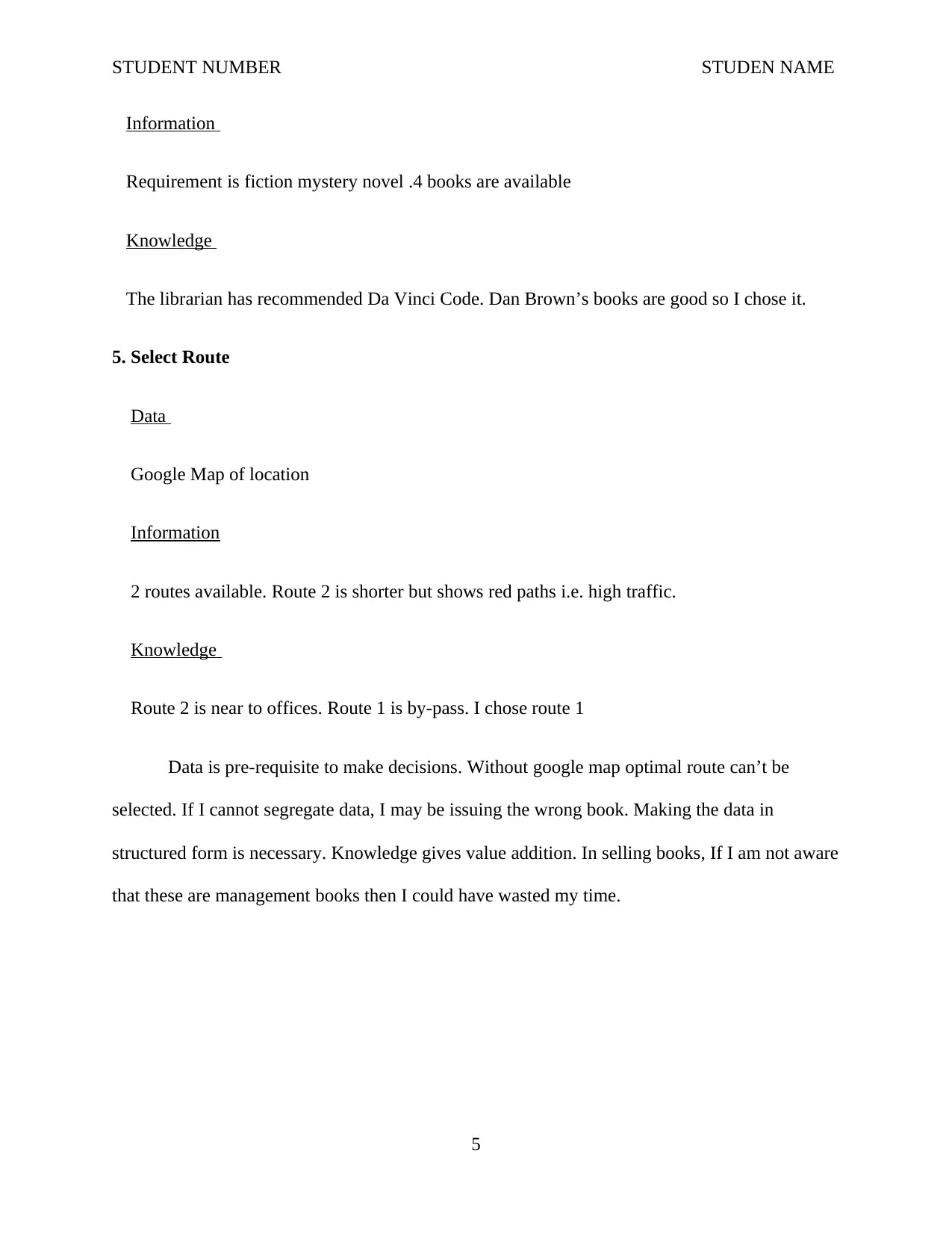
STUDENT NUMBER STUDEN NAME
Information
Requirement is fiction mystery novel .4 books are available
Knowledge
The librarian has recommended Da Vinci Code. Dan Brown’s books are good so I chose it.
5. Select Route
Data
Google Map of location
Information
2 routes available. Route 2 is shorter but shows red paths i.e. high traffic.
Knowledge
Route 2 is near to offices. Route 1 is by-pass. I chose route 1
Data is pre-requisite to make decisions. Without google map optimal route can’t be
selected. If I cannot segregate data, I may be issuing the wrong book. Making the data in
structured form is necessary. Knowledge gives value addition. In selling books, If I am not aware
that these are management books then I could have wasted my time.
5
Information
Requirement is fiction mystery novel .4 books are available
Knowledge
The librarian has recommended Da Vinci Code. Dan Brown’s books are good so I chose it.
5. Select Route
Data
Google Map of location
Information
2 routes available. Route 2 is shorter but shows red paths i.e. high traffic.
Knowledge
Route 2 is near to offices. Route 1 is by-pass. I chose route 1
Data is pre-requisite to make decisions. Without google map optimal route can’t be
selected. If I cannot segregate data, I may be issuing the wrong book. Making the data in
structured form is necessary. Knowledge gives value addition. In selling books, If I am not aware
that these are management books then I could have wasted my time.
5
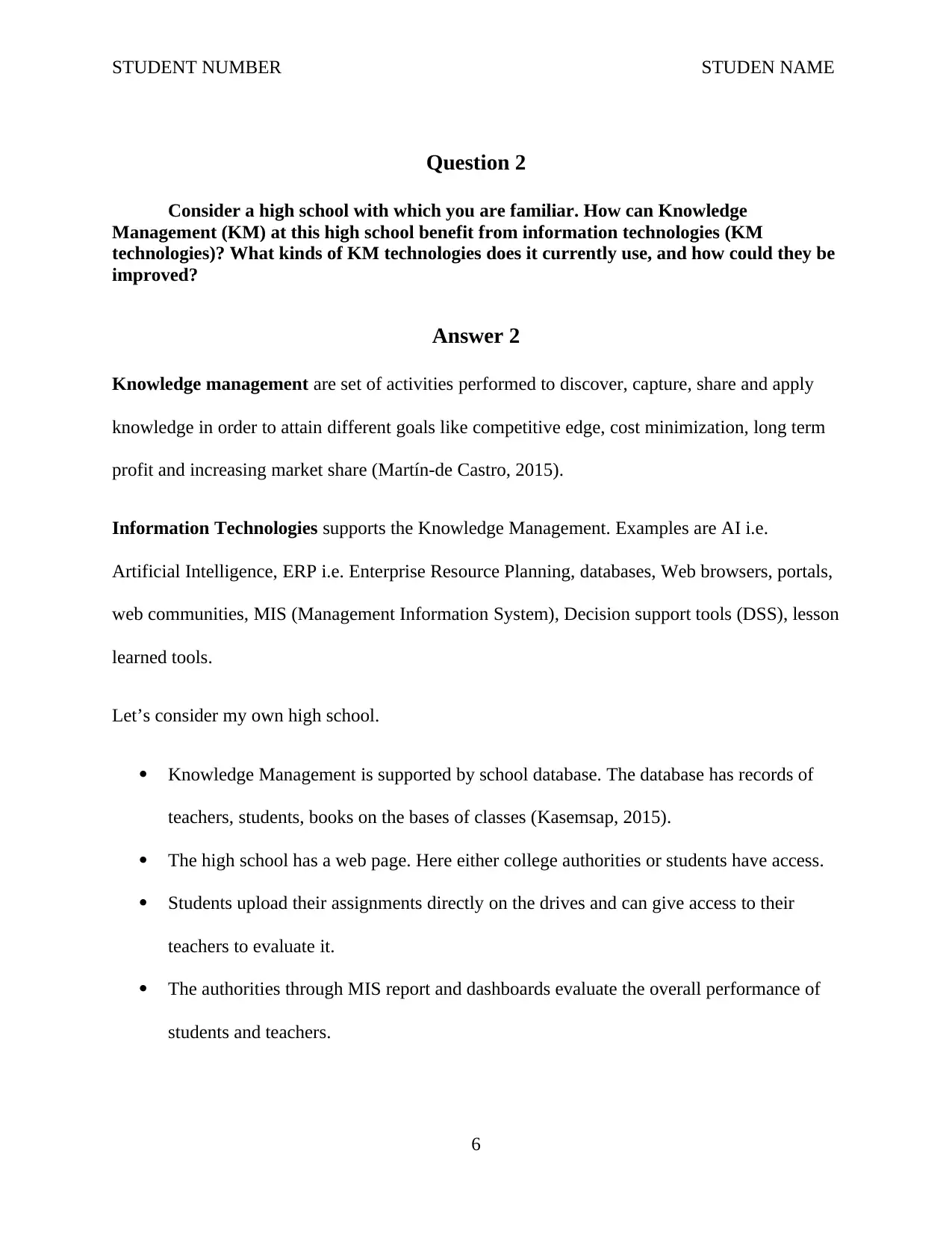
STUDENT NUMBER STUDEN NAME
Question 2
Consider a high school with which you are familiar. How can Knowledge
Management (KM) at this high school benefit from information technologies (KM
technologies)? What kinds of KM technologies does it currently use, and how could they be
improved?
Answer 2
Knowledge management are set of activities performed to discover, capture, share and apply
knowledge in order to attain different goals like competitive edge, cost minimization, long term
profit and increasing market share (Martín-de Castro, 2015).
Information Technologies supports the Knowledge Management. Examples are AI i.e.
Artificial Intelligence, ERP i.e. Enterprise Resource Planning, databases, Web browsers, portals,
web communities, MIS (Management Information System), Decision support tools (DSS), lesson
learned tools.
Let’s consider my own high school.
Knowledge Management is supported by school database. The database has records of
teachers, students, books on the bases of classes (Kasemsap, 2015).
The high school has a web page. Here either college authorities or students have access.
Students upload their assignments directly on the drives and can give access to their
teachers to evaluate it.
The authorities through MIS report and dashboards evaluate the overall performance of
students and teachers.
6
Question 2
Consider a high school with which you are familiar. How can Knowledge
Management (KM) at this high school benefit from information technologies (KM
technologies)? What kinds of KM technologies does it currently use, and how could they be
improved?
Answer 2
Knowledge management are set of activities performed to discover, capture, share and apply
knowledge in order to attain different goals like competitive edge, cost minimization, long term
profit and increasing market share (Martín-de Castro, 2015).
Information Technologies supports the Knowledge Management. Examples are AI i.e.
Artificial Intelligence, ERP i.e. Enterprise Resource Planning, databases, Web browsers, portals,
web communities, MIS (Management Information System), Decision support tools (DSS), lesson
learned tools.
Let’s consider my own high school.
Knowledge Management is supported by school database. The database has records of
teachers, students, books on the bases of classes (Kasemsap, 2015).
The high school has a web page. Here either college authorities or students have access.
Students upload their assignments directly on the drives and can give access to their
teachers to evaluate it.
The authorities through MIS report and dashboards evaluate the overall performance of
students and teachers.
6
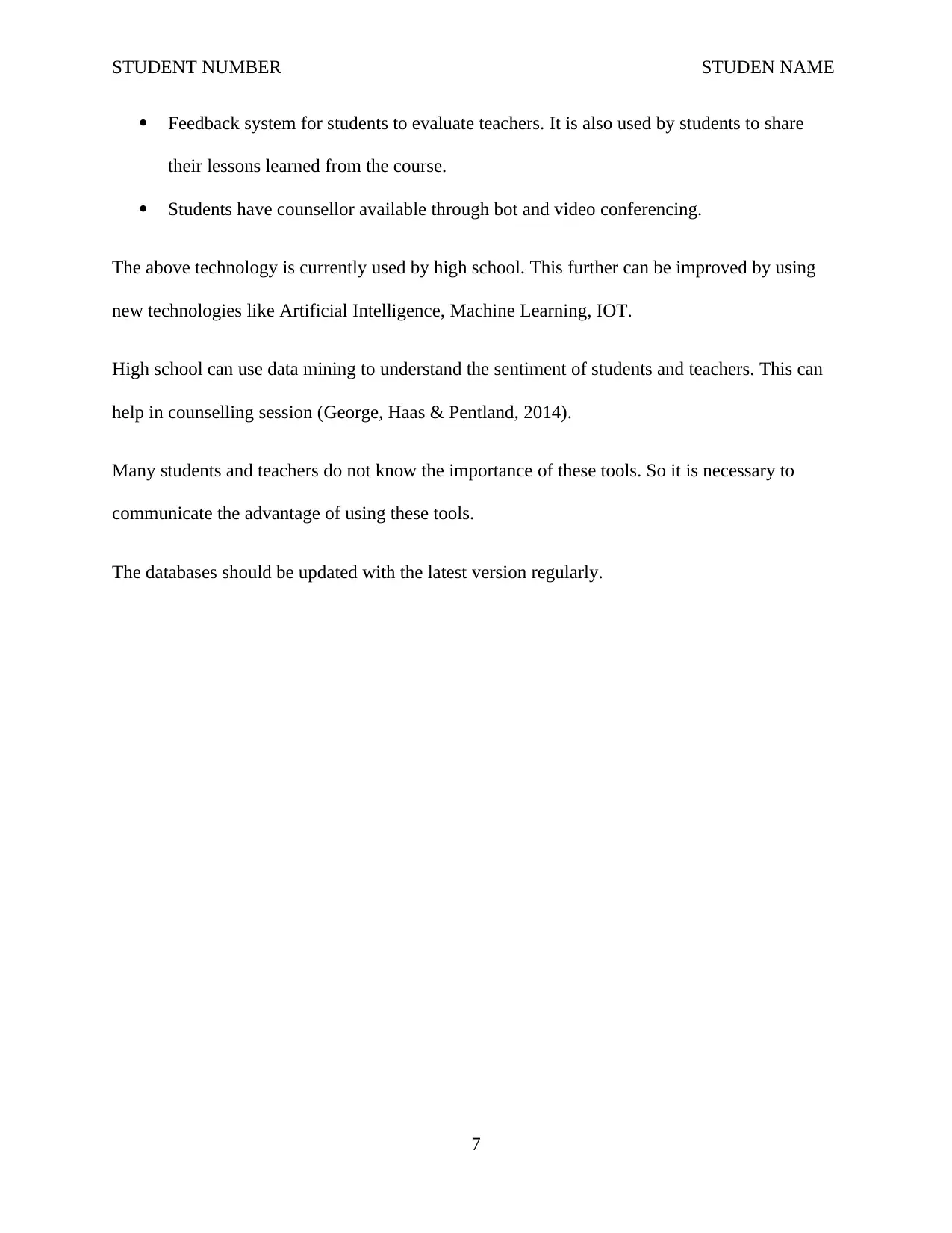
STUDENT NUMBER STUDEN NAME
Feedback system for students to evaluate teachers. It is also used by students to share
their lessons learned from the course.
Students have counsellor available through bot and video conferencing.
The above technology is currently used by high school. This further can be improved by using
new technologies like Artificial Intelligence, Machine Learning, IOT.
High school can use data mining to understand the sentiment of students and teachers. This can
help in counselling session (George, Haas & Pentland, 2014).
Many students and teachers do not know the importance of these tools. So it is necessary to
communicate the advantage of using these tools.
The databases should be updated with the latest version regularly.
7
Feedback system for students to evaluate teachers. It is also used by students to share
their lessons learned from the course.
Students have counsellor available through bot and video conferencing.
The above technology is currently used by high school. This further can be improved by using
new technologies like Artificial Intelligence, Machine Learning, IOT.
High school can use data mining to understand the sentiment of students and teachers. This can
help in counselling session (George, Haas & Pentland, 2014).
Many students and teachers do not know the importance of these tools. So it is necessary to
communicate the advantage of using these tools.
The databases should be updated with the latest version regularly.
7
Paraphrase This Document
Need a fresh take? Get an instant paraphrase of this document with our AI Paraphraser
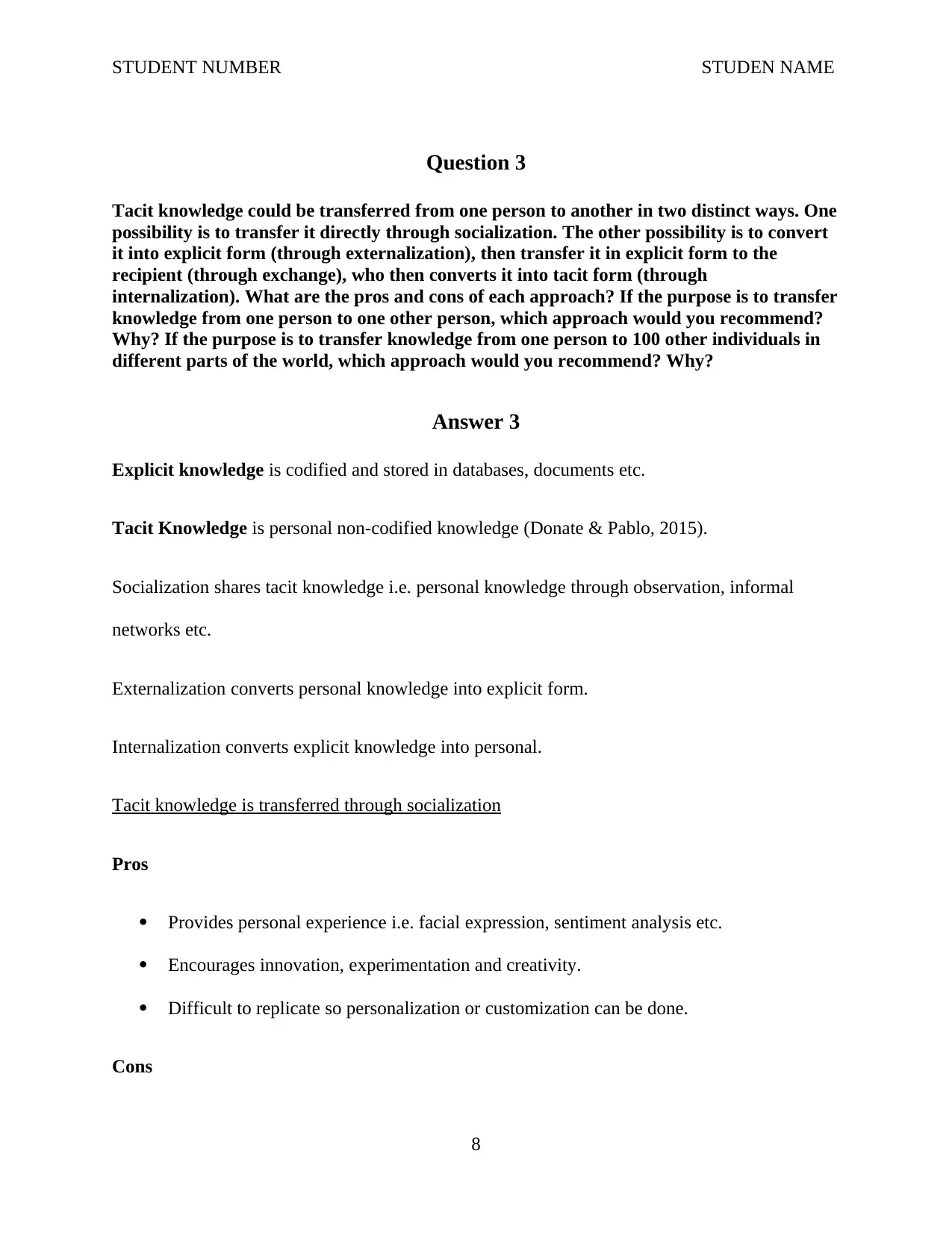
STUDENT NUMBER STUDEN NAME
Question 3
Tacit knowledge could be transferred from one person to another in two distinct ways. One
possibility is to transfer it directly through socialization. The other possibility is to convert
it into explicit form (through externalization), then transfer it in explicit form to the
recipient (through exchange), who then converts it into tacit form (through
internalization). What are the pros and cons of each approach? If the purpose is to transfer
knowledge from one person to one other person, which approach would you recommend?
Why? If the purpose is to transfer knowledge from one person to 100 other individuals in
different parts of the world, which approach would you recommend? Why?
Answer 3
Explicit knowledge is codified and stored in databases, documents etc.
Tacit Knowledge is personal non-codified knowledge (Donate & Pablo, 2015).
Socialization shares tacit knowledge i.e. personal knowledge through observation, informal
networks etc.
Externalization converts personal knowledge into explicit form.
Internalization converts explicit knowledge into personal.
Tacit knowledge is transferred through socialization
Pros
Provides personal experience i.e. facial expression, sentiment analysis etc.
Encourages innovation, experimentation and creativity.
Difficult to replicate so personalization or customization can be done.
Cons
8
Question 3
Tacit knowledge could be transferred from one person to another in two distinct ways. One
possibility is to transfer it directly through socialization. The other possibility is to convert
it into explicit form (through externalization), then transfer it in explicit form to the
recipient (through exchange), who then converts it into tacit form (through
internalization). What are the pros and cons of each approach? If the purpose is to transfer
knowledge from one person to one other person, which approach would you recommend?
Why? If the purpose is to transfer knowledge from one person to 100 other individuals in
different parts of the world, which approach would you recommend? Why?
Answer 3
Explicit knowledge is codified and stored in databases, documents etc.
Tacit Knowledge is personal non-codified knowledge (Donate & Pablo, 2015).
Socialization shares tacit knowledge i.e. personal knowledge through observation, informal
networks etc.
Externalization converts personal knowledge into explicit form.
Internalization converts explicit knowledge into personal.
Tacit knowledge is transferred through socialization
Pros
Provides personal experience i.e. facial expression, sentiment analysis etc.
Encourages innovation, experimentation and creativity.
Difficult to replicate so personalization or customization can be done.
Cons
8
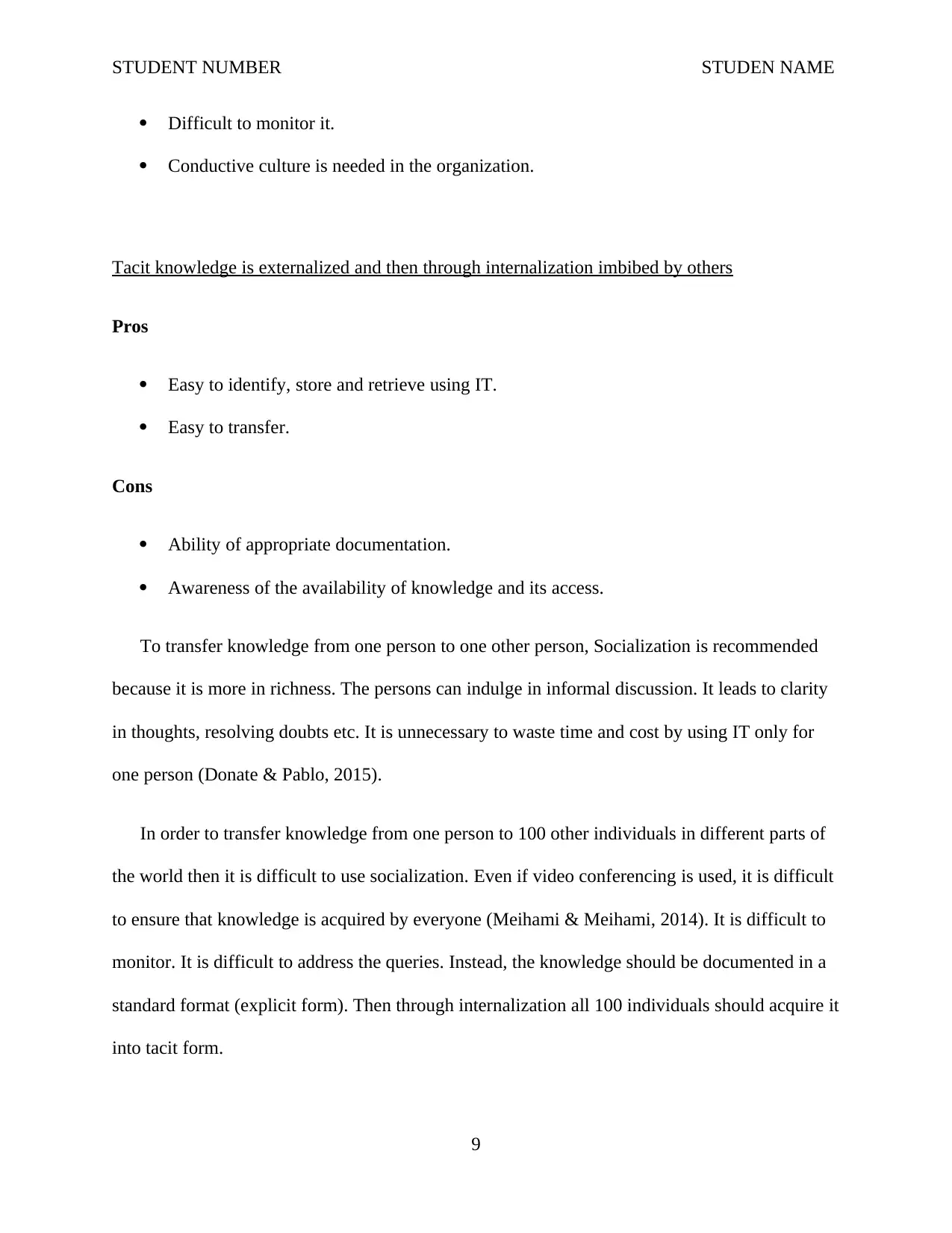
STUDENT NUMBER STUDEN NAME
Difficult to monitor it.
Conductive culture is needed in the organization.
Tacit knowledge is externalized and then through internalization imbibed by others
Pros
Easy to identify, store and retrieve using IT.
Easy to transfer.
Cons
Ability of appropriate documentation.
Awareness of the availability of knowledge and its access.
To transfer knowledge from one person to one other person, Socialization is recommended
because it is more in richness. The persons can indulge in informal discussion. It leads to clarity
in thoughts, resolving doubts etc. It is unnecessary to waste time and cost by using IT only for
one person (Donate & Pablo, 2015).
In order to transfer knowledge from one person to 100 other individuals in different parts of
the world then it is difficult to use socialization. Even if video conferencing is used, it is difficult
to ensure that knowledge is acquired by everyone (Meihami & Meihami, 2014). It is difficult to
monitor. It is difficult to address the queries. Instead, the knowledge should be documented in a
standard format (explicit form). Then through internalization all 100 individuals should acquire it
into tacit form.
9
Difficult to monitor it.
Conductive culture is needed in the organization.
Tacit knowledge is externalized and then through internalization imbibed by others
Pros
Easy to identify, store and retrieve using IT.
Easy to transfer.
Cons
Ability of appropriate documentation.
Awareness of the availability of knowledge and its access.
To transfer knowledge from one person to one other person, Socialization is recommended
because it is more in richness. The persons can indulge in informal discussion. It leads to clarity
in thoughts, resolving doubts etc. It is unnecessary to waste time and cost by using IT only for
one person (Donate & Pablo, 2015).
In order to transfer knowledge from one person to 100 other individuals in different parts of
the world then it is difficult to use socialization. Even if video conferencing is used, it is difficult
to ensure that knowledge is acquired by everyone (Meihami & Meihami, 2014). It is difficult to
monitor. It is difficult to address the queries. Instead, the knowledge should be documented in a
standard format (explicit form). Then through internalization all 100 individuals should acquire it
into tacit form.
9

STUDENT NUMBER STUDEN NAME
10
10
Secure Best Marks with AI Grader
Need help grading? Try our AI Grader for instant feedback on your assignments.
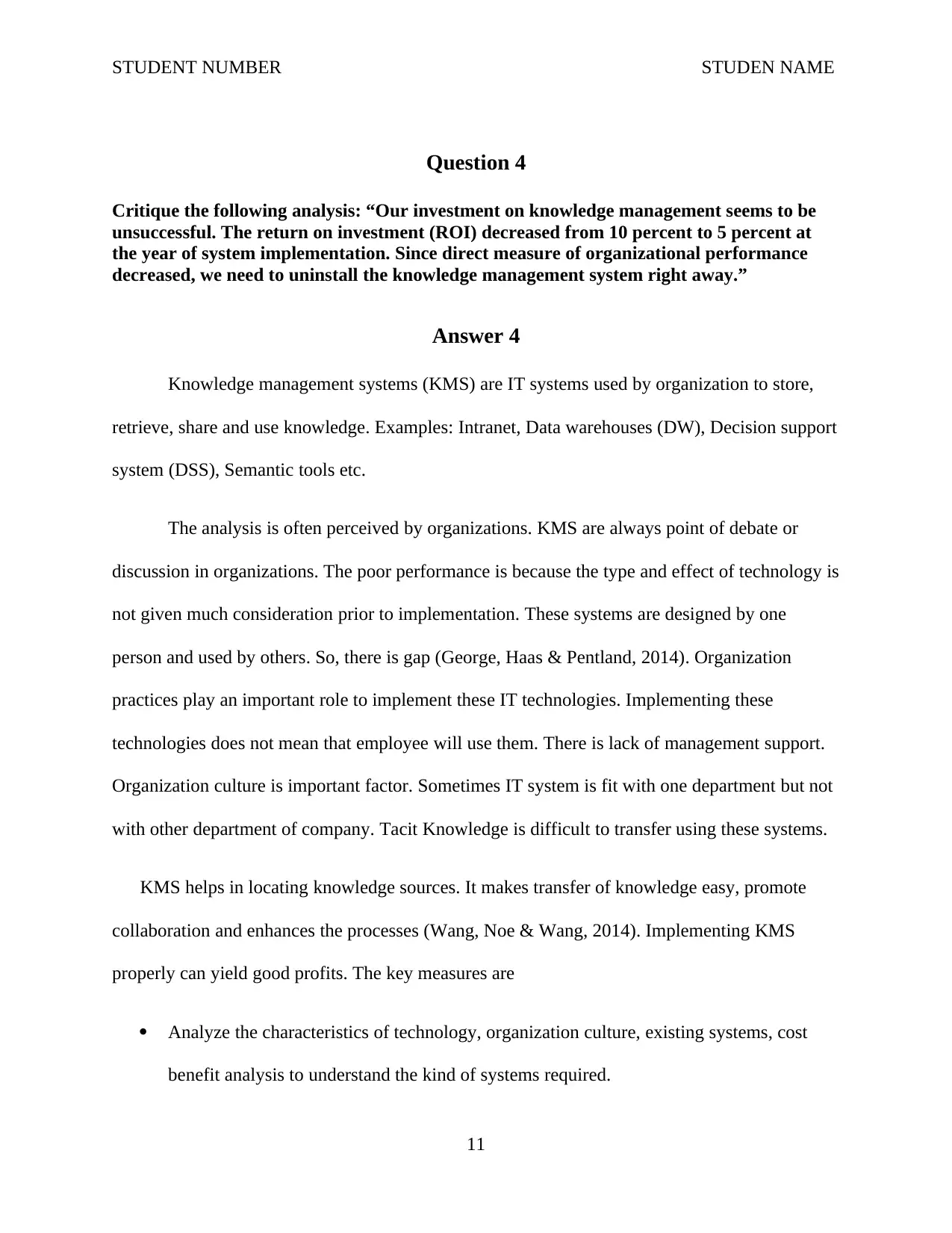
STUDENT NUMBER STUDEN NAME
Question 4
Critique the following analysis: “Our investment on knowledge management seems to be
unsuccessful. The return on investment (ROI) decreased from 10 percent to 5 percent at
the year of system implementation. Since direct measure of organizational performance
decreased, we need to uninstall the knowledge management system right away.”
Answer 4
Knowledge management systems (KMS) are IT systems used by organization to store,
retrieve, share and use knowledge. Examples: Intranet, Data warehouses (DW), Decision support
system (DSS), Semantic tools etc.
The analysis is often perceived by organizations. KMS are always point of debate or
discussion in organizations. The poor performance is because the type and effect of technology is
not given much consideration prior to implementation. These systems are designed by one
person and used by others. So, there is gap (George, Haas & Pentland, 2014). Organization
practices play an important role to implement these IT technologies. Implementing these
technologies does not mean that employee will use them. There is lack of management support.
Organization culture is important factor. Sometimes IT system is fit with one department but not
with other department of company. Tacit Knowledge is difficult to transfer using these systems.
KMS helps in locating knowledge sources. It makes transfer of knowledge easy, promote
collaboration and enhances the processes (Wang, Noe & Wang, 2014). Implementing KMS
properly can yield good profits. The key measures are
Analyze the characteristics of technology, organization culture, existing systems, cost
benefit analysis to understand the kind of systems required.
11
Question 4
Critique the following analysis: “Our investment on knowledge management seems to be
unsuccessful. The return on investment (ROI) decreased from 10 percent to 5 percent at
the year of system implementation. Since direct measure of organizational performance
decreased, we need to uninstall the knowledge management system right away.”
Answer 4
Knowledge management systems (KMS) are IT systems used by organization to store,
retrieve, share and use knowledge. Examples: Intranet, Data warehouses (DW), Decision support
system (DSS), Semantic tools etc.
The analysis is often perceived by organizations. KMS are always point of debate or
discussion in organizations. The poor performance is because the type and effect of technology is
not given much consideration prior to implementation. These systems are designed by one
person and used by others. So, there is gap (George, Haas & Pentland, 2014). Organization
practices play an important role to implement these IT technologies. Implementing these
technologies does not mean that employee will use them. There is lack of management support.
Organization culture is important factor. Sometimes IT system is fit with one department but not
with other department of company. Tacit Knowledge is difficult to transfer using these systems.
KMS helps in locating knowledge sources. It makes transfer of knowledge easy, promote
collaboration and enhances the processes (Wang, Noe & Wang, 2014). Implementing KMS
properly can yield good profits. The key measures are
Analyze the characteristics of technology, organization culture, existing systems, cost
benefit analysis to understand the kind of systems required.
11
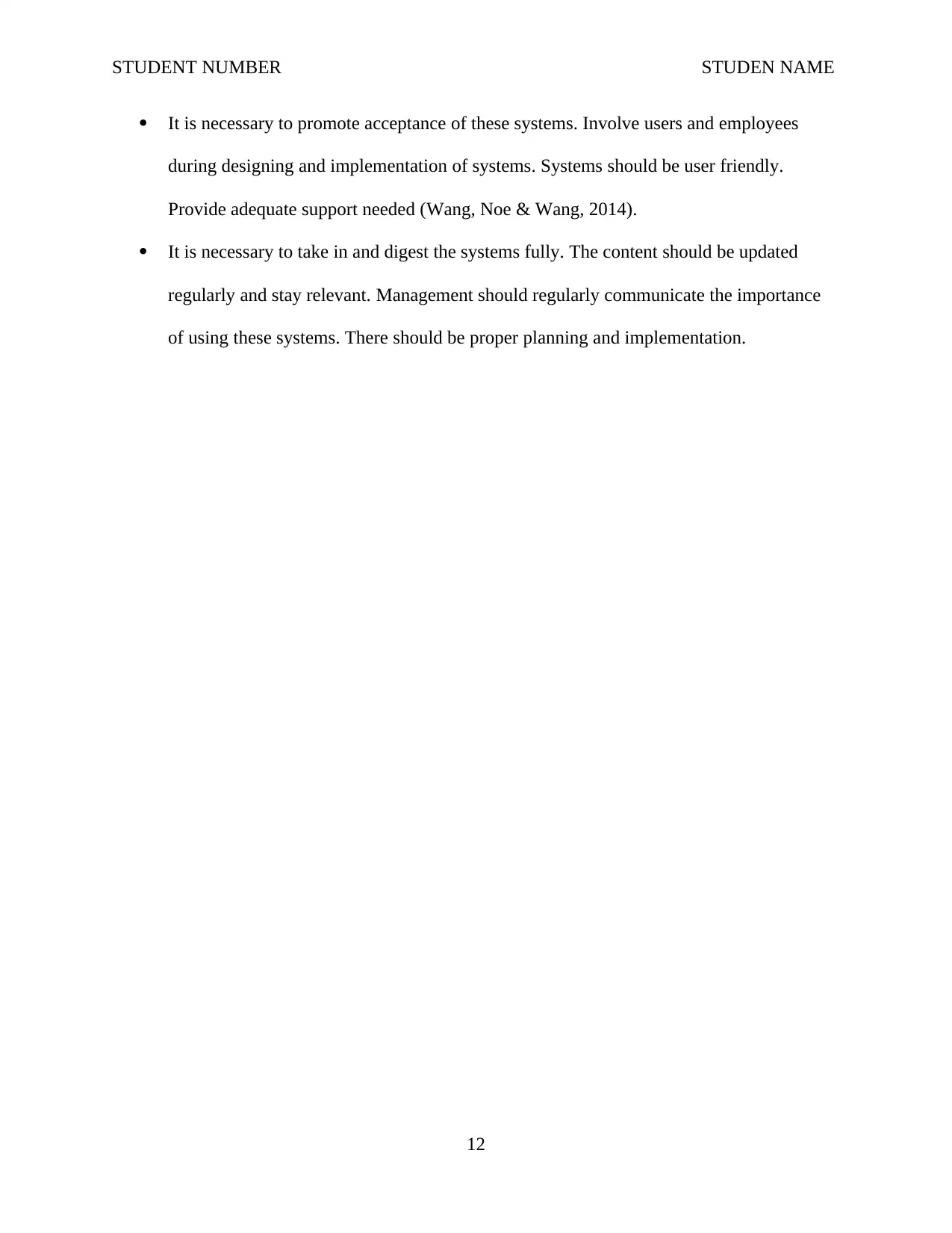
STUDENT NUMBER STUDEN NAME
It is necessary to promote acceptance of these systems. Involve users and employees
during designing and implementation of systems. Systems should be user friendly.
Provide adequate support needed (Wang, Noe & Wang, 2014).
It is necessary to take in and digest the systems fully. The content should be updated
regularly and stay relevant. Management should regularly communicate the importance
of using these systems. There should be proper planning and implementation.
12
It is necessary to promote acceptance of these systems. Involve users and employees
during designing and implementation of systems. Systems should be user friendly.
Provide adequate support needed (Wang, Noe & Wang, 2014).
It is necessary to take in and digest the systems fully. The content should be updated
regularly and stay relevant. Management should regularly communicate the importance
of using these systems. There should be proper planning and implementation.
12
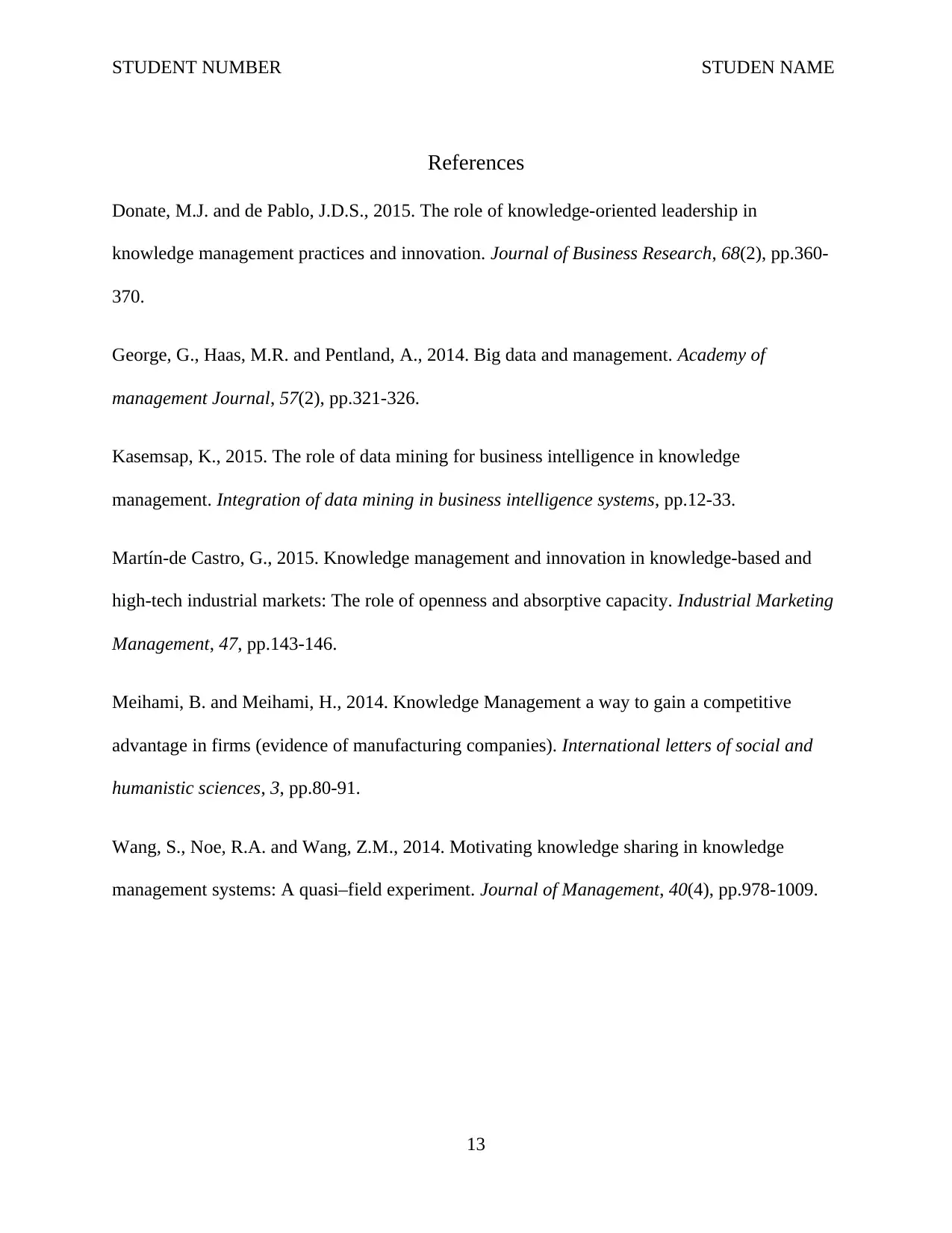
STUDENT NUMBER STUDEN NAME
References
Donate, M.J. and de Pablo, J.D.S., 2015. The role of knowledge-oriented leadership in
knowledge management practices and innovation. Journal of Business Research, 68(2), pp.360-
370.
George, G., Haas, M.R. and Pentland, A., 2014. Big data and management. Academy of
management Journal, 57(2), pp.321-326.
Kasemsap, K., 2015. The role of data mining for business intelligence in knowledge
management. Integration of data mining in business intelligence systems, pp.12-33.
Martín-de Castro, G., 2015. Knowledge management and innovation in knowledge-based and
high-tech industrial markets: The role of openness and absorptive capacity. Industrial Marketing
Management, 47, pp.143-146.
Meihami, B. and Meihami, H., 2014. Knowledge Management a way to gain a competitive
advantage in firms (evidence of manufacturing companies). International letters of social and
humanistic sciences, 3, pp.80-91.
Wang, S., Noe, R.A. and Wang, Z.M., 2014. Motivating knowledge sharing in knowledge
management systems: A quasi–field experiment. Journal of Management, 40(4), pp.978-1009.
13
References
Donate, M.J. and de Pablo, J.D.S., 2015. The role of knowledge-oriented leadership in
knowledge management practices and innovation. Journal of Business Research, 68(2), pp.360-
370.
George, G., Haas, M.R. and Pentland, A., 2014. Big data and management. Academy of
management Journal, 57(2), pp.321-326.
Kasemsap, K., 2015. The role of data mining for business intelligence in knowledge
management. Integration of data mining in business intelligence systems, pp.12-33.
Martín-de Castro, G., 2015. Knowledge management and innovation in knowledge-based and
high-tech industrial markets: The role of openness and absorptive capacity. Industrial Marketing
Management, 47, pp.143-146.
Meihami, B. and Meihami, H., 2014. Knowledge Management a way to gain a competitive
advantage in firms (evidence of manufacturing companies). International letters of social and
humanistic sciences, 3, pp.80-91.
Wang, S., Noe, R.A. and Wang, Z.M., 2014. Motivating knowledge sharing in knowledge
management systems: A quasi–field experiment. Journal of Management, 40(4), pp.978-1009.
13
1 out of 13
Related Documents
Your All-in-One AI-Powered Toolkit for Academic Success.
+13062052269
info@desklib.com
Available 24*7 on WhatsApp / Email
![[object Object]](/_next/static/media/star-bottom.7253800d.svg)
Unlock your academic potential
© 2024 | Zucol Services PVT LTD | All rights reserved.




